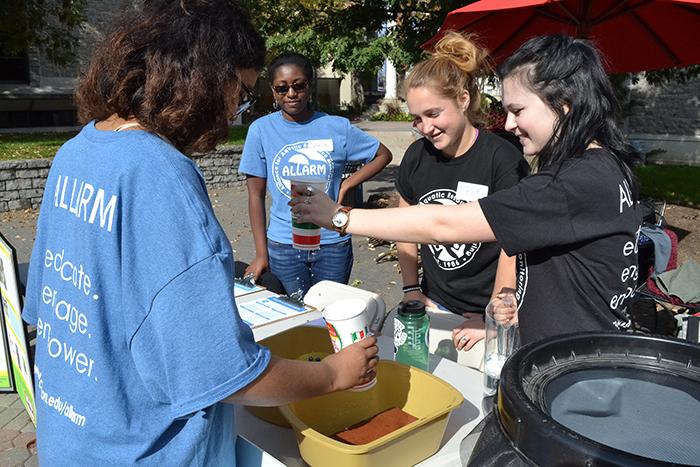Conodoguinet Conservation

ALLARM students test water samples during the Stormwater Spectacular on Britton Plaza. Photo by Carl Socolow '77.
‘Snapshot’ Provides Glimpse Into Creek’s Health
by Craig Layne
Dickinson College’s Alliance for Aquatic Resource Monitoring (ALLARM) and the Cumberland County Conservation District (CCCD) will host a community collaborative event aimed at teaching local volunteers to collect and analyze water samples from the Conodoguinet Creek watershed. The free, public event will take place Saturday, Dec. 2, from 9 a.m. to noon in Kaufman Hall, Room 124. People interested in collecting water samples and participating in the workshop should sign up online by Nov. 24.
The session is part of ALLARM and CCCD’s water quality “snapshot” for the Conodoguinet Creek watershed, which collects data on stream health once per season. The Conodoguinet, a tributary of the Susquehanna River and Chesapeake Bay, has a 540-square-mile drainage basin that includes much of Cumberland County. Volunteers will collect samples from across the watershed, and bring them to the ALLARM lab, where volunteers will test the samples for important stream-health indicators, including temperature, pH, nitrate-nitrogen and orthophosphate content. Dickinson students will assist volunteers in testing the samples.
“This is an exciting community project,” said Julie Vastine, director of ALLARM. “While there have been data collected on the creek over time, this is the first watershed-wide effort to capture data in 12 years.”
The “snapshot” is ALLARM’s first local partnership through its Environmental Protection Agency-funded Chesapeake Monitoring Cooperative, a six-year grant to help promote community based monitoring and integrate data into understanding the health of the Chesapeake Bay watershed. Local partners include the Big Spring Watershed Association, Conodoguinet Creek Watershed Association and Middle Spring Watershed Association. So far, more than 30 volunteers have helped capture data at 20 sites throughout the watershed.
Learn More
Published November 14, 2017